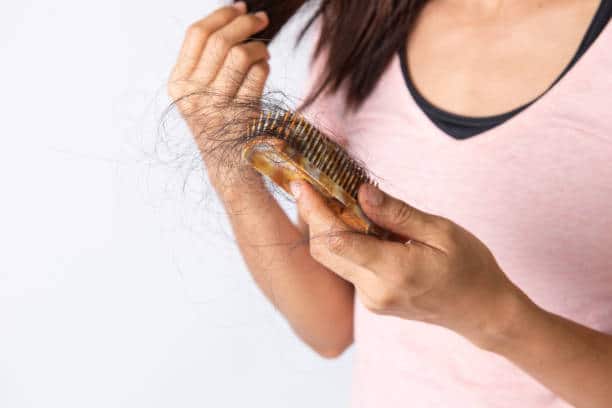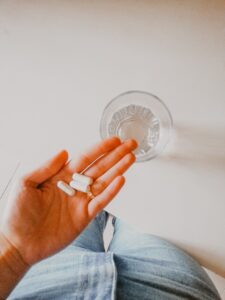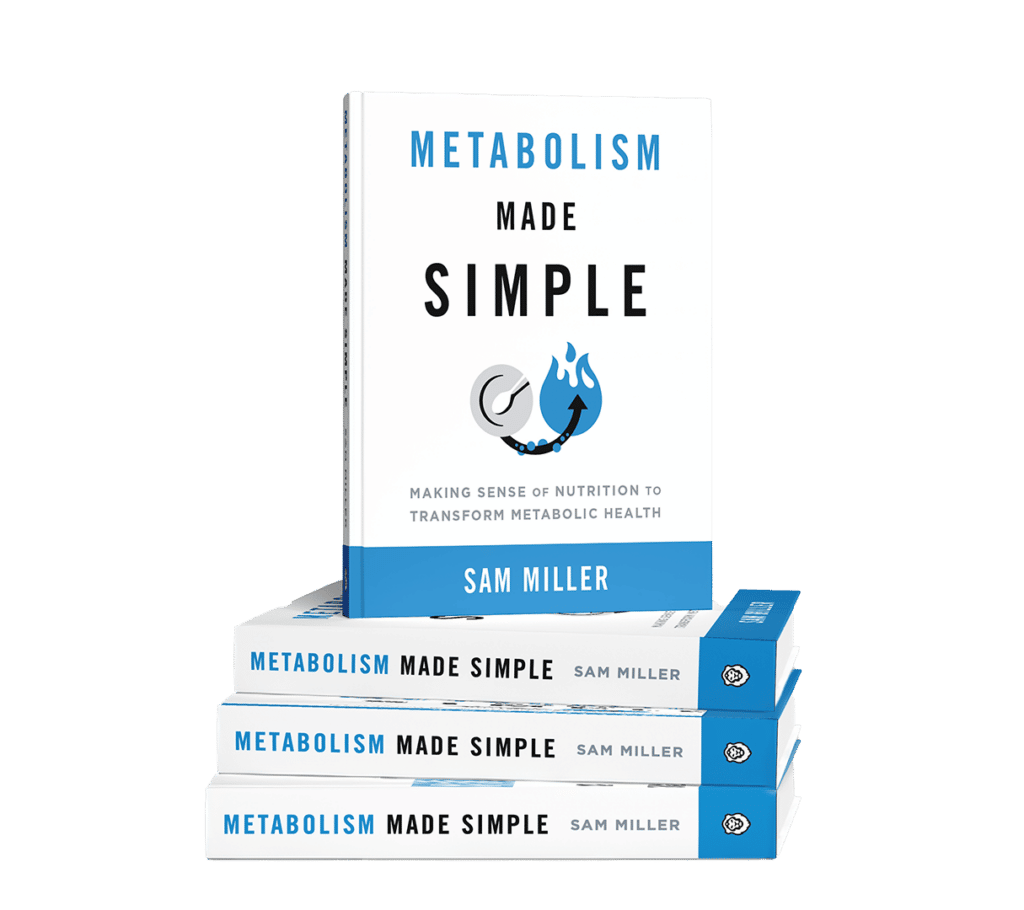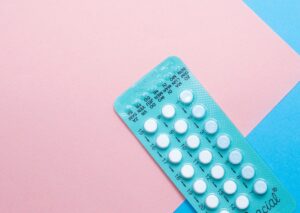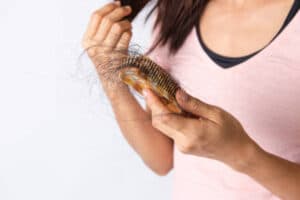acan can Introduction
Everyone knows how attractive a great, thick head of hair can be on both a man or a woman. A nice head of hair can be a symbol of health and power; one might think of the Biblical story of Samson. For those unaware, Samson was a man of supraphysiological strength, and his hair was the source of his power.
Although once someone is suffering from hair loss, they’re obviously not going to lose physical strength, it can certainly feel like it.
Hair loss can affect one’s self-image, self-esteem, and psychological state, so hair loss is a topic sensitive to many people, both men and women alike.
At some point in their lives, whether it’s at 30 years old or 70, most men will begin to notice a bit more skin peeking through their crown, or that dreaded horseshoe appearing in the mirror. Male pattern baldness is certainly the primary reason for men to lose their hair, however, its not the only type of hair loss.
Hair loss simply isn’t a problem that’s relegated to men. Many women suffer from thinning hair, increased hair loss, or patchy hair loss as well. This post will dive into general hair health, reasons for hair loss in both sexes, and how we can best mitigate the issues.
Post Layout:
- Common causes and types of hair loss
- How do you know what type of hair loss you or your clients are experiencing?
- A little bit on basic hair physiology
- Dive into 3 main types of hair loss and treatment options for each
- Pharmaceutical treatments and their downfalls
- Alternative treatments and how they work
Common Causes of Hair Loss
There are many different conditions or sources of hair loss, probably around 6-8 different ones. However, we’ll be focusing on three of the more common causes:
- Androgenetic alopecia, or male pattern baldness is the most common cause for men.
- Telogen effluvium, which is one of the most common causes of non-male pattern hair loss and can be triggered by many things such as micronutrient deficiencies, too low calories, hypothyroidism and stress.
- Alopecia Areata, which is a type of hair loss that is autoimmune in nature and can affect men and women alike, and not just on the top of the head. It’s characterized by local, patchy hair loss that can occur anywhere on the head or body.
How To Delineate Between Causes
Before we actually dive into talking about the specific root causes, if you or a client is suffering from hair loss, how do you know which version it is? You’ll learn a bit more as we go along, but let’s go ahead and give a nutshell explanation here.
If you’re a man, and you notice hair loss is occurring slightly later in age and starting slow, as well as occurring in a typical “horseshoe” receding hairline fashion or on the crown, these are all signs of common male pattern baldness.
If you’re a woman and have elevated androgens for whatever reason; this is commonly seen in PCOS for example, AND if you have the genetic predisposition, you can also be experiencing what’s typically known as “male pattern baldness” which would look much the same as it does in men: The horseshoe-shaped receding hairline. This may also be accompanied by unwanted hair growth on the face, neck, back, etc.
Telogen effluvium is going to happen as a result of poor diet (nutrient deficiencies, inflammatory diet, etc), high life stress, and this is also the type of hair loss that occurs with hypothyroidism.
We’ll dive into a bit more of the causes later, but the first signs are typically thinning hair; in other words, the single strands of hair don’t appear as healthy or as full as they used to.
Upon brushing or pulling, large clumps of hair may fall out as well. This doesn’t have the same pattern of male pattern baldness.
Telogen effluvium is going to present as hair thinning potentially anywhere or everywhere on the head, and hair loss can occur uniformly throughout the head as well.
The last one, Alopecia areata, is an autoimmune condition. This type of hair loss is localized; that is, usually small circular patches on the head, face (like beards), or body can fall out. Very different from both typical male pattern baldness and telogen effluvium and fairly easy to recognize.
Keep in mind there are other types of hair loss, although they are quite rare, so this is not a comprehensive list.
Hair Physiology and the 3 Phases of Hair Growth
Before we jump into it, we’ll be referencing a few terms you should probably know a bit about; namely different phases of hair growth.
Some people are under the impression that all hair is actively growing, which isn’t true. Hair growth follows a simple cycle. A growth phase where hair is actively growing, a phase where hair is transitioning to dormancy, and then a stage where the hair is finished growing and is basically resting and waiting to fall out for hair growth to begin again.
The first phase is the anagen phase. “Ana”, like anabolic, meaning growth in nature, so when you hear anagen, you can think of hair that’s actively growing. During this phase, scalp hair grows about 1 cm every month.
Scalp hair stays in this phase on average from 2 to 6 years. Individuals that struggle to grow very long hair may have much shorter anagen phases than people who have no problem growing their hair out. You can kind of think of the anagen phase as a human’s first 1 to 18ish years of life; still actively growing and maturing.
The second phase is the catagen phase. This is a transitional phase between anagen and the last phase, and about 3% of the average individual’s hair is in this stage at any given time. In this phase, the hair stops growing, and the root sheath attaches firmly to the hair root, causing the formation of a club hair, which is basically just the end product of hair growth.
Finally, we have the telogen phase. While the catagen stage is basically the transitional stage where the hair actively stops growing and the club hair is formed, the telogen stage is the end product of that; hair that is in a resting state, waiting to fall out and begin the cycle again.
In other words, you have this tiny little bit of time in the transition (catagen), and then you reach dormancy (telogen). About 6 to 8% of the average individual’s hair is in the telogen state at any given time. The hair loses about 1/6th of its diameter, does not grow, and is basically waiting to fall out so that the hair growth cycle can restart.
The average person loses about 50-100 telogen hairs per day, which is typically what you’ll see after you brush your hair, shower, etc. Those are all telogen-state or dormant hairs coming out. Actively growing hair does not do this.
Staying with the human growth analogy we have, you can think of this state as after the human body stops growing after the first 18-20ish years of life. Growth, in terms of height anyway, is complete and will not occur again.
Androgenetic Alopecia or Male Pattern Baldness
Let’s start by addressing male pattern baldness, since most men will be experiencing this to some degree throughout their lives. Keep in mind this can actually affect females as well, although at a much lower rate and really only in specific contexts.
Prevalence data suggests that about 30% of white males will experience it by age 30, 50% by age 50, and 80% by age 70. There’s not solid prevalence data on other ethnicities, but it is known that most other ethnicities suffer from this at significantly lower rates than caucasians.
Causes
Genetics – The main thing that first has to be in place are the genetics for predisposition. Some men can have all the androgens in the world, but won’t experience male pattern baldness, or at least have it delayed to very late in life. Conversely, men with low testosterone can still experience male pattern baldness at similar rates.
We won’t go into specific gene names here, because it’s not all that helpful, but you might’ve heard an old wives tale or common “wisdom” that hair genetics comes from the mother’s side. As in, if your maternal grandfather had a full head of hair up to death, so will you.
However, it’s not that simple. Recent studies show that both the maternal grandfather and your immediate father play about an equal role in contributing, so if you’re quite young and worried about it in the future, take a look at both your dad and your grandfather on your mom’s side to potentially see what you’re in for.
If they’re balding, ask when they started balding so you might have an idea of when it might start for you so you can be prepared. It’s not a 1 to 1, but it’ll give you a general idea.
Androgens
If you haven’t figured it out by now, once genetics are in place, then the next cause would be androgens. Although hair growth is also regulated by thyroid and glucocorticoid hormones, androgens are the most powerful and important regulators. Androgens drive hair growth in nearly every other place on the body besides the scalp, where we know it can do the opposite.
The main culprit here is dihydrotestosterone or DHT; this is a metabolite of testosterone via the 5AR enzyme that is about 8 to 10 times more androgenic than testosterone itself. Testosterone still contributes, but not even close to as much as DHT.
Interestingly, in men predisposed, circulating androgen levels can be at nearly any level (except well below reference range) and men can still experience this. This is because the skin has all the machinery necessary to create its own testosterone and DHT, and it does that to a much greater extent in those men that are predisposed.
In other words, a man can still be experiencing male pattern baldness at a serum testosterone level of 220, and also a serum DHT level at the lower end of the reference range, simply because what’s happening in serum does not reflect what’s happening in the skin.
To bring it all together, the reason some men can have circulating androgen levels over 1000 and experience no or minimal male pattern baldness, while someone at 250 can, is because of all of the local things happening in the skin and hair follicles.
Getting a bit deeper into the physiology, it mainly depends on androgen receptor density in the hair follicle. Bald men consistently always have a higher androgen receptor density in the hair follicle than men that aren’t bald.
We also have androgen production and conversion to consider. The skin could possibly be producing less overall testosterone, and could also possibly have less 5AR enzymes hanging around, meaning less of that testosterone will be converted to DHT. It’s a large symphony of factors that are contributing here.
The cascade of androgens binding to androgen receptors increases oxidative stress within the hair follicle, causing all sorts of cell damage and cutoff of oxygen delivery, which is currently hypothesized to be the main source of hair thinning and loss from androgens.
What we can do about Male Pattern Baldness
Firstly, if you’re a female and you’re experiencing this, resolving the cause of elevated androgens will resolve this; again the most common reason for this is going to be PCOS. I have a lot of content out there on PCOS, so we won’t dive into that here. Search the Sam Miller Science podcast feed if you’d like to learn more about that.
Pharmaceutical Treatments
Minoxidil is one of the first lines of defense, and it works by improving blood flow to the hair follicles. This has the effect of not necessarily preventing hair loss or increasing hair growth (although it does the latter a little bit), but mainly by increasing hair diameter.
It tends to increase it back to what it was prior to the beginning of male pattern baldness, so the hair looks more full overall. It does come with some potential side effects that include rashes and skin inflammation, headaches, dizziness, and chest pains.
5AR inhibitors are the next class of drugs, and probably the most common. These would be drugs like finasteride or dutasteride, and they work by inhibiting the 5 alpha reductase enzyme, which basically prevents the conversion of testosterone to DHT. Oral 5AR inhibitors particularly can also come with a host of side effects: Depression, anxiety, other cognitive changes, low libido, potential gynecomastia, and erectile dysfunction.
Newer generation, topical 5AR inhibitors are going to be a much better route than oral in terms of minimizing side effects. Whenever we take something orally, it affects the entire system. If we apply topically, yes, inevitably some will get into circulation and go systemic, but most stays in the area of application. Topical 5AR inhibitors may be a viable route if the following alternative therapies are out of reach or inefficacious for you particularly.
PFS – Post-Finasteride Syndrome
I’d be remiss not to mention the possibility of post-finasteride syndrome. This is currently not recognized as much in literature, although many doctors do acknowledge its existence.
When some men discontinue finasteride (usually due to negative side effects such as depression and no libido) the side effects that they stopped the drug for can persist for many months, if not years.
There is some speculation in the medical community that there may be epigenetic changes in the 5AR enzyme, potentially shutting down genetic expression, lowering DHT levels even after the drug is removed. This has not been tested in scientific research yet.
Alternative Therapies
Copper peptides, namely GHK-Cu, are a common alternative treatment within the more functional health space. GHK-Cu started to be evaluated because it actually has a lot of potential beneficial health effects.
For example, it can stimulate blood vessels and nerve growth and thus promote wound healing, increase collagen synthesis, and have numerous other effects, including being highly anti-inflammatory and increasing DNA synthesis and repair.
Exactly how GHK-Cu works for hair is still being worked out, but since it has extremely strong anti-inflammatory AND antioxidant capabilities, this is probably the largest contributor. Since male pattern baldness might be because of the oxidative stress caused by DHT binding the AR, a topical solution applied to the head may decrease this significantly. It does not influence androgen levels, so you don’t have side effects associated with that.
Carbon 60 is another potential alternative treatment. If you remember much of your high school chemistry, you might recognize this as a buckyball.
A few scientists won the nobel prize back in 1996 for its discovery. It can be used to make ultra-hard material coatings for things like nanomachines and space material, and its thought that it might be able to replace silicon in all its applications one day.
That’s besides the point; in humans, it can also act as an extremely powerful free radical scavenger. Starting to see a trend here? Studies show that a topical cream of C60 can help increase hair growth, and the mechanism is probably the decrease in oxidative stress as well. Using this in conjunction with GHK-Cu as a topical would be a good idea, and there are several products out there that combine both.
PRP injections are another popular route to go. PRP stands for platelet rich plasma; basically what happens here is the practitioner draws a small amount of blood from you, then separates out each fraction: plasma, red and white blood cells, and platelets. Plasma is added back to the platelets and then injected. Injection into the scalp has been shown to increase blood vessel formation around the hair roots, and basically puts hair cells back in the anagen, or active growth stage. One study suggests a protocol of 3 monthly sessions, followed by 3 bimonthly sessions, and then repeating this if hair loss begins again.
Photobiomodulation, AKA red light therapy, is a popular topic in the health space right now, and may also be efficacious for hair regrowth. A quality red light therapy device (aka not a cheap one you buy off Amazon) can increase hair growth if used on a daily basis.
All you have to do is expose the area you want to re-grow for 20-60 minutes on a daily basis. The way it works is pretty interesting; red light therapy can stimulate mitochondrial activity in the stem cell of the hair follicle. Normally, stem cells don’t have access to as much oxygen, and normally rely on glycolysis so they don’t use their mitochondria very much (remember glycolysis occurs in the cell cytoplasm, not in the mitochondria).
However, since RLT stimulates their mitochondria, the stem cells will leave their niche so they can find the oxygen they need for their newfound metabolism. This results in more hair follicle differentiation and an increase in the anagen phase of hair growth.
That pretty much completes treatment options for male pattern baldness. Alot of these can be used for alopecia areata and telogen effluvium as well while you’re working on the root cause of those. I’ll explain in a bit.
Telogen Effluvium
This is the type of hair loss that’s induced mainly by lifestyle. Telogen effluvium seems to affect women more than men, but this could be confounded by the fact that many men might write off their hair loss as regular male pattern baldness and may not seek evaluation or treatment as readily.
It occurs when some environmental or internal factor causes significantly more hair than normal to enter the telogen phase, or the resting/dormant phase. Remember, this thins the hair and stops growth, allowing more hair to fall out than normal. If you notice your hair is significantly thinner than normal, and you’re brushing your hair and noticing significantly larger clumps falling out, this is possibly what could be occurring.
Causes
Stress is one of the primary causes of TE. Physiological stress like surgical trauma, high fever, chronic illness, chronic sleep loss, and chronic overtraining can cause telogen effluvium. Psychological stress can cause this as well, although psychological stress is confounded by the fact that hair loss causes psychological stress itself, but many people that experience telogen effluvium report high psychological stress before their hair loss/thinning began.
There are some very common drugs that can cause telogen effluvium as well; these include antidepressants (SSRI’s and others), oral birth control, retinoids (like accutane), blood pressure medications like beta blockers and ACE inhibitors, anticonvulsants and anticoagulants.
Medical conditions like anemia, hypo- and hyperthyroidism, IBD, IBS (including gut infections), and liver and kidney failure can cause telogen effluvium. If these things are taken care of, telogen effluvium will reverse.
There are many different dietary factors that can contribute. From a macronutrient perspective; if we’re too low calorie for too long (physiological stress), or if we have a protein or fatty acid deficiency, this will invariably cause telogen effluvium. Deficiencies of specific nutrients can cause this as well; namely zinc, iron (thus the anemia we spoke about above), biotin, and vitamin D.
There has been an association between excessive UV exposure and TE; it was noticed that telogen effluvium increased significantly between the months of May and September, creating a potential link to ultraviolet light exposure.
If you’re experiencing what you think might be telogen effluvium, do an audit of your lifestyle and see if any of the things I just talked about ring true with you – If they do, modify one or two things first to see if it makes a difference and go from there.
Alopecia Areata
AA, as I mentioned at the beginning, is autoimmune in nature. It can present as small as one circular or oval patch of hair loss on the head, or affect all hair follicles over the entire body. It most commonly occurs in multiple small circular or oval patches on the head, however.
With this condition, the immune system attacks the hair follicle keratinocytes and this results in inhibition of cell division within the hair matrix, leading to growth stopping and hair subsequently falling out.
Interestingly, it can also commonly occur alongside Hashimoto’s hypothyroidism with a prevalence between 8 and 27%, depending on the study you look at, so if you or a client is suffering from Hashimoto’s with concomitant hair loss, you should really look at the character of the hair loss to see if its the normal associated telogen effluvium or AA.
Once again, telogen effluvium is going to just look like much thinner hair overall, as well as clumps of hair coming out when you brush, whereas AA is very distinct with the patchiness.
As with all autoimmune diseases, we’re looking to calm the immune system’s damage on the hair follicles, and in most cases we can accomplish this through diet and lifestyle.
We first must have the basic foundations of optimized sleep and managed stress in place.
Then, in scouring the literature and also anecdote, there’s a lot of combined data from those two things to suggest that elimination diets can have a huge impact on AA. For example, there is a published case study that simply eliminating gluten and dairy completely reversed AA for a patient.
In the published case study, the individual completely avoided gluten/dairy, ate plenty of micronutrient dense foods, supplemented high dose omega 3s, zinc, probiotics, vitamin D, and vitamin A, and had resolution and significant hair regrowth within 2 months, and complete hair regrowth within 5 months.
Others that did not have success with eliminating just gluten and dairy went full on AIP and saw good success with that, along with making sure the nutrients that help with self-tolerance are high (zinc and vitamin D, along with omega 3s for optimal inflammatory signaling).
The take home here is there’s not a one-size-fits all with AA. You can start with simple elimination of gluten and dairy so as not to be so restrictive, but consider going further if you don’t find success.
There’s no rule against using the aforementioned techniques and products for treatment of male pattern baldness, as it might accelerate re-growth once you find the right diet and lifestyle patterns. As a reminder, that would be the GHK-Cu peptides and Carbon 60 as topical creams, platelet rich plasma injections, and red light therapy.
Conclusion
I hope you learned something actionable to take home to either yourself, your clients, or your friends and family today. If you’re experiencing hair loss, then you don’t necessarily have to suffer through it.
As a woman, the most common cause is going to be telogen effluvium, and generally the most common avatar I see anecdotally is a combination of stress, eating too little (micronutrient deficiencies + too low calories), birth control usage, and/or SSRI usage.
Male pattern baldness will affect most men at some point in their lives, and they can potentially mitigate this through the alternative therapies of GHK-Cu, Carbon 60 creams, photobiomodulation, and/or PRP. If these fail, a topical 5AR inhibitor plus minoxidil may be efficacious and as long as the 5AR inhibitor is topical, come with minimal side effects.
References
Hoover E, Alhajj M, Flores JL. Physiology, Hair. [Updated 2021 Jul 26]. In: StatPearls [Internet]. Treasure Island (FL): StatPearls Publishing; 2022 Jan-. Available from: https://www.ncbi.nlm.nih.gov/books/NBK499948/
Phillips TG, Slomiany WP, Allison R. Hair Loss: Common Causes and Treatment. Am Fam Physician. 2017 Sep 15;96(6):371-378. PMID: 28925637.
Fabbrocini G, Cantelli M, Masarà A, Annunziata MC, Marasca C, Cacciapuoti S. Female pattern hair loss: A clinical, pathophysiologic, and therapeutic review. Int J Womens Dermatol. 2018 Jun 19;4(4):203-211. doi: 10.1016/j.ijwd.2018.05.001. PMID: 30627618; PMCID: PMC6322157.
Wang ECE, Dai Z, Ferrante AW, Drake CG, Christiano AM. A Subset of TREM2+ Dermal Macrophages Secretes Oncostatin M to Maintain Hair Follicle Stem Cell Quiescence and Inhibit Hair Growth. Cell Stem Cell. 2019 Apr 4;24(4):654-669.e6. doi: 10.1016/j.stem.2019.01.011. Epub 2019 Mar 28. PMID: 30930146.
Zhou Shuying, Qi Fei, Gong Yue, Zhang Chenxi, Zhao Siqi, Yang Xutong, He Yanling. Platelet-Rich Plasma in Female Androgenic Alopecia: A Comprehensive Systematic Review and Meta-Analysis. Frontiers in Pharmacology, volume 12, 2021. https://www.frontiersin.org/article/10.3389/fphar.2021.642980. DOI: 10.3389/fphar.2021.642980
Trüeb, R.M., Dias, M.F.R.G. Alopecia Areata: a Comprehensive Review of Pathogenesis and Management. Clinic Rev Allerg Immunol 54, 68–87 (2018). https://doi.org/10.1007/s12016-017-8620-9
Lolli F, Pallotti F, Rossi A, Fortuna MC, Caro G, Lenzi A, Sansone A, Lombardo F. Androgenetic alopecia: a review. Endocrine. 2017 Jul;57(1):9-17. doi: 10.1007/s12020-017-1280-y. Epub 2017 Mar 28. PMID: 28349362.
Asghar F, Shamim N, Farooque U, Sheikh H, Aqeel R. Telogen Effluvium: A Review of the Literature. Cureus. 2020 May 27;12(5):e8320. doi: 10.7759/cureus.8320. PMID: 32607303; PMCID: PMC7320655.
Meidan VM, Touitou E. Treatments for androgenetic alopecia and alopecia areata: current options and future prospects. Drugs. 2001;61(1):53-69. doi: 10.2165/00003495-200161010-00006. PMID: 11217871.
Pickart L, Margolina A. Regenerative and Protective Actions of the GHK-Cu Peptide in the Light of the New Gene Data. Int J Mol Sci. 2018 Jul 7;19(7):1987. doi: 10.3390/ijms19071987. PMID: 29986520; PMCID: PMC6073405.
Rondags A, Yuen WY, Jonkman MF, Horváth B. Fullerene C60 with cytoprotective and cytotoxic potential: prospects as a novel treatment agent in Dermatology? Exp Dermatol. 2017 Mar;26(3):220-224. doi: 10.1111/exd.13172. Epub 2017 Feb 2. PMID: 27541937.
Gentile P, Garcovich S, Bielli A, Scioli MG, Orlandi A, Cervelli V. The Effect of Platelet-Rich Plasma in Hair Regrowth: A Randomized Placebo-Controlled Trial. Stem Cells Transl Med. 2015 Nov;4(11):1317-23. doi: 10.5966/sctm.2015-0107. Epub 2015 Sep 23. PMID: 26400925; PMCID: PMC4622412.
Ferrando J, García-García SC, González-de-Cossío AC, Bou L, Navarra E. A Proposal of an Effective Platelet-rich Plasma Protocol for the Treatment of Androgenetic Alopecia. Int J Trichology. 2017 Oct-Dec;9(4):165-170. doi: 10.4103/ijt.ijt_27_17. PMID: 29118521; PMCID: PMC5655625.
Hamblin MR. Photobiomodulation for the management of alopecia: mechanisms of action, patient selection and perspectives. Clin Cosmet Investig Dermatol. 2019 Sep 6;12:669-678. doi: 10.2147/CCID.S184979. PMID: 31686888; PMCID: PMC6737896.
Harvey CJ. Combined Diet and Supplementation Therapy Resolves Alopecia Areata in a Paediatric Patient: A Case Study. Cureus. 2020 Nov 7;12(11):e11371. doi: 10.7759/cureus.11371. PMID: 33304703; PMCID: PMC7721078.
Harvey CJ. Combined Diet and Supplementation Therapy Resolves Alopecia Areata in a Paediatric Patient: A Case Study. Cureus. 2020 Nov 7;12(11):e11371. doi: 10.7759/cureus.11371. PMID: 33304703; PMCID: PMC7721078.
[/et_pb_text][/et_pb_column][/et_pb_row][/et_pb_section]
